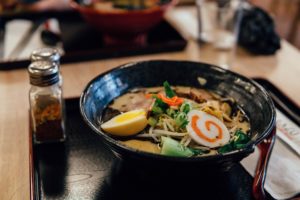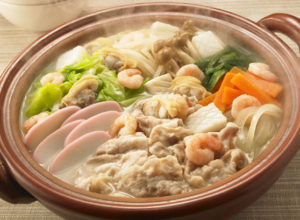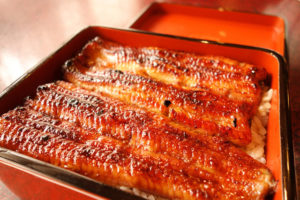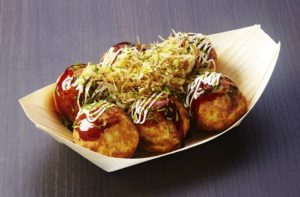My top 4 Japanese dishes that I can eat anytime, anywhere!
It is too difficult to decide on just four dishes since I love food in general and traditional Japanese food in particular. I tried lots of things, and I loved them all.
Some of my favorites are: uni (sea urchin), natto (YES!!) – traditional style with raw egg and thinly slices leek, miso, tempura, Kitsune Soba, unagi (fried eel), sukiyaki, nabe, oden, etc.! There are much more, but it would take pages.
So I tried to think, which ones are my favorite ones, but since I loved them all, I had to ask this question differently. If my mother came to Japan (which she did), what would be the top 4 dishes I would like her to taste?
No. 1: Tonkotsu Ramen – ramen pub under a bridge

In Japan, there are some tiny local Ramen restaurants, similar to taverns, that foreigners usually avoid. They look a little uncomfortable and seem to invite only Japanese people. Well, this is where you will find the best Ramen.
I took my mother to one of them, and we both had different types of Ramen so she could try different varieties. She loved them, and even after a few years, she still remembers how impressed she was with this little Ramen pub. For sure recommend, don’t be shy, just take a friend with you!
No. 2: Nabe or hot pot dishes

I love warm soupy dishes, and Nabe is one of my favorite. Sometimes, you make it yourself (shabu-shabu or sukiyaki), but most of the time the waiter will bring it, and it has a small candle underneath the pot so you can enjoy it super hot. I love the countryside varieties with lots of vegetables and some meat.
Nabe is another dish I had my mother try, but at that time I think she was more impressed with the restaurant than anything else. We went to a very traditional restaurant where she had to take her shoes off, and the table was low and with a hole beneath it.
I believe there is nothing more pleasant than returning from skying to your ryokan on a freezing winter day and warming up with a hot nabe. It just makes you feel life is good.
No. 3: Unagi – Japanese fried eel

Unagi is another one of my favorites, and for a MEXT student maybe a little expensive, about 3500 yen (30 USD). Truly delicious, the soft but firm texture of the eel, the salty-sweet sauce, and plain boiled rice.
You can eat the best eel at specialized unagi restaurants. I bought it from supermarkets as well and warmed it up in the microwave, but it just isn’t the same. The taste is different, less spectacular.
Unagi is something I only ate in Japan, and although you can probably find it in other Asian countries, I haven’t seen it in Europe. I was very impressed with the eel. It has a unique, exquisite taste!
No. 4: Takoyaki – fried octopus in flour batter

Takoyaki is a traditional Japanese food you find at all festivals or anywhere they have street food. The round balls are made of fried batter, and inside they have a little bit of octopus, pickled ginger, and vegetables. They are small but hot, and you should be careful with them, don’t try to eat it in one gulp, it will just burn your tongue.
I had one Takoyaki shop near the school I worked, and every time I passed by, I bought the takoyaki. Also, I went to a Japanese friend’s house and experimented a little with this dish. Instead of making takoyaki, we prepared Cheese-Yaki – same, but with cheese instead of octopus. I loved it, and it was fun, we ate so much!
I don’t remember if my mum tried the takoyaki. She only stayed one month in Japan with me, but for sure, it is not enough! I think a lifetime in Japan is still not enough to try everything and discover all its beauty and mysteries. Simply lovely!
Conclusion
So these are my top 4 Japanese traditional dishes. Maybe except for unagi which is a treat, any MEXT student can easily enjoy them at a very reasonable price.
So if you are already in Japan or plan on applying for the MEXT scholarship, don’t be shy, try everything and go to these small pubs or Japanese traditional sweets shops. You will surely enjoy the taste of traditional Japanese food. Traditional Japanese food is at the very core of the country’s soul and culture. Itadakimasu!
PS: Learn how to use chopsticks like a real Japanese!
[spacer height=”40px”]
